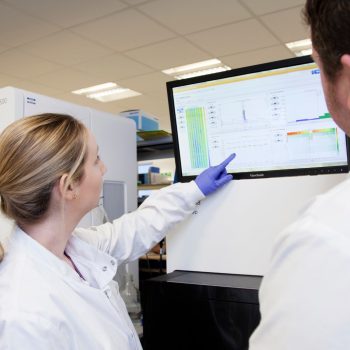Rare “knockout” gene mutations in humans help scientists determine gene function
Identifying the function of every human gene is a key goal in medicine to understand health and what goes wrong in disease, but scientists still only know what a fraction of the estimated 20,000 genes in the human genome do.
In an international collaboration published in Nature, researchers from the University of Cambridge School of Clinical Medicine, Broad Institute of MIT and Harvard, University of Pennsylvania (UPenn), and the Center for Non-Communicable Diseases in Pakistan, analysed a Pakistani population in which relatives frequently intermarry to find humans with rare gene-disabling (“knockout”) DNA mutations and determine the consequences for health and disease.
In Pakistan, marriages between closely related individuals have been customary for generations, and children from such unions are more likely to inherit disabled versions of a gene from both parents, rendering them with no working copies of the gene. This study, with a cohort of more than 10,000 individuals, is one of the first to look in detail at such a population and the effects of these mutations. More than 1,300 genes were completely knocked out in at least one individual, allowing the research team to investigate what happens when there is complete loss of gene function.
The researchers showcase one particular knockout mutation in APOC3, a gene previously found responsible for maintaining dietary fat in the blood. The team identified a family with both copies of APOC3 disabled, and showed that these individuals are able to clear fat from their bloodstreams much more quickly than relatives who retained functional copies. When combined with an earlier report indicating that lacking one copy of APOC3 leads to lower risk for heart attack, these data suggest that a medicine developed to mimic these APOC3 knockout mutations could prevent heart attacks.
“The Human Genome Project revealed the genetic blueprint for human life, but we’re now entering a new era in genetics where we can systematically examine what it means for humans when parts of this blueprint are missing,” says co-senior author John Danesh, British Heart Foundation (BHF) Professor of Epidemiology and Medicine and Director of the MRC/BHF Cardiovascular Epidemiology Unit at Cambridge University and theme lead for the NIHR Cambridge BRC. “This has been made possible by advances in DNA sequencing technology and analytical capabilities to deal with the avalanche of data produced, combined with access to people who naturally lack functioning copies of particular genes.”
“To determine what a gene does, traditionally scientists ‘delete’ it in a mouse or a zebrafish and observe what happens. However, due to species differences, findings based on such experiments cannot always be extrapolated to humans,” says James Peters, BHF Clinical Research Fellow in Danesh’s group. “In contrast, this study leverages the high degree of consanguinity (relatedness) in Pakistan to find naturally-occurring gene knock-outs with direct relevance to human health and disease”.
Prof. Danesh, along with the paper’s first author Danish Saleheen, led the assembly of a cohort in Pakistan to study the genetic risk of heart disease. Participants provided blood samples for genetic sequencing and analysis of more than 200 biological traits such as cholesterol and insulin levels. But in the sequence data from the first few thousand participants, the researchers noted a large number of knocked-out genes, and pivoted to study the consequences of these genetic variations.
Previous human cohort studies have generated lists of potentially disabled genes in participants, but the team went a step further in the current study, correlating the nonfunctional genes with the physiological measurements. Within the cohort, the researchers found 1,317 genes where at least one person had both of their copies disabled. Roughly a third of these disabled genes existed in two or more people, allowing for further analysis, and the team determined that seven of the disrupted genes were associated with at least one of the measured traits.
Most notable was a family in which the parents, who were first cousins, both had two disabled copies of the gene APOC3. The research team returned to this family for clinical evaluation and found that those without a working version of APOC3 cleared dietary fat from their blood at a faster rate than other relatives could with one or two functional APOC3 genes. The natural power of APOC3-disabling mutations to lower this risk factor for heart disease could be a boon for preventative therapies, following the roadmap laid out by study of a different gene called PCSK9. “Studying individuals with gene knock-outs can help guide drug development, by mimicking the effects of a drug that blocks the protein made by that gene”, says Danesh. In 2005, a group of researchers reported that a nonfunctional version of PCSK9 was associated with lower blood cholesterol, and a year later, researchers described an adult woman with two non-functional copies of PCSK9 — indicating that humans could tolerate complete loss of this gene. Such observations eventually led to the development of medications that block PCSK9, and these medications are now approved by the U.S. Food and Drug Administration to lower blood LDL cholesterol.
“This research provides a framework that could be scaled up to establish a global ‘human knockout’ project: scouring populations for humans with naturally-occurring knockout mutations, and determining the range of physical consequences stemming from that gene-function loss to better understand the genome,” says co-first author Pradeep Natarajan, a postdoctoral research fellow in Sekar Kathiresan’s lab at the Broad Institute. Going forward, this study suggests that genome sequencing efforts focused on highly consanguinous populations will provide the greatest yields.
Written by the University of Cambridge, this research was funded by the NIHR Cambridge BRC



